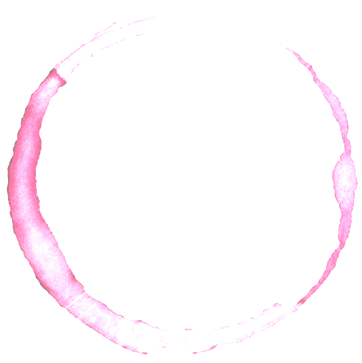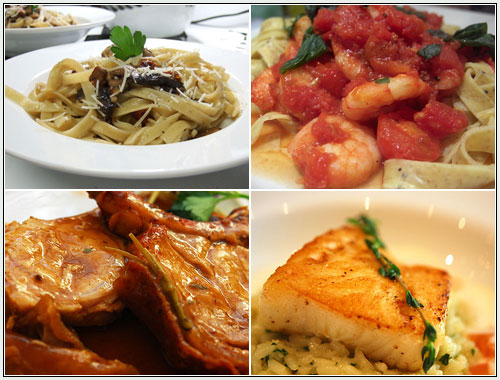
< Previous / Next >
 |
Article Index < Previous / Next > |

Food and Wine Pairing - tips and tricks
Before I suggest anything related to food and wine pairings, let me
emphasize that taste is a matter of personal preference, and that what may
seem obscure to one person is sure to appeal to another. In other
words, in the privacy of your own company, drink what you like and pair it
with what you enjoy. Should your plans include a house full of guests, you
might want to follow a few basic guidelines to ensure that creativity does
not exceed expectation...
Please take your time, there is a great deal of material
in this article to digest (pun intended). You can also click the print icon
at the bottom of the post for a hard copy.

In General
Enjoy → White before Red - Dry before Sweet - Young
before Old
Consider the meal as a summation of flavours and
textures. The wine that you select should be one that compliments the
overall package, i.e. the richer the dish, the more full and flavourful the
wine required.
Many people turn their nose up at the thought of acidity
in wine. We're not talking extreme pH here, but rather just enough zip to
get your taste buds tingling before the next mouthful. It is the acidity in
both food and wine that makes you salivate; without it, many taste
combinations would become dull, flat, and in some case cloying.
The Cliché: Red with meat and White with fish…
sure, why not? It works - as a general rule. But with the mix of
cultures plus the introduction of new dishes and cooking methods, there is
so much more to consider beyond this catchall philosophy.
Consider:
The method of preparation: Raw, steamed, or boiled
food has a lighter flavour intensity when compared to that which is braised,
roasted, or grilled.
In many cases, you must pair the wine with the sauce and
not with what is underneath.
Side dishes: A roast turkey itself is generally a
mild flavoured meat. The dressing, gravy, and side dishes however add
a multitude of flavours and textures to the equation.
Pairing Techniques:
Respect the older wine regions’ culinary and viticultural
history; the two have likely grown together. A fail-safe method of pairing
is to consider the origin of the food and choose a wine from that region.
Some food/wine pairings are ‘like for like’ while others
pose the idea that ‘opposites’ attract. Do you want the wine to ‘enhance’
the flavours of the dish or act as a ‘highlight’ by contrasting flavours and
textures?
→ Like for Like: An element of the dish will compliment a
similar quality in the wine i.e. Pork and applesauce with the apple flavours
of Chardonnay.
‘Bridge Ingredients’ are additions to the dish that
enhance both the flavour and texture of a pairing. Examples are the minty
aroma of a cool climate Cabernet Sauvignon and mint seasoning in a dish such
a lamb. Another bridge is to pair an oaked Chardonnay with a dish
containing toasted hazelnuts or almonds. The oak influence of the wine
barrels imparts these same characteristics to the wine and the two combine
to complement each other in the pairing.
→ Contrasting (opposite) flavours and textures: Every
wonder why bitter salad greens pair so well with a acidic dressing?
Individually, both elements are somewhat unappealing, but together the two
tastes and textures mingle perfectly. The same concept works well with food
and wine pairings and the most common example is to combine a crisp, acidic
wine with a rich cream-based dish. The heavy texture and flavours of the
food are whisked away with each refreshing sip of the wine leaving a clean
palate for the next bite.
Consider the flavour of the dish: Sour / Sharp / Savoury
(Umami) / Spicy / Smoky / Sweet
Sour/sharp tastes call for a similar level of acidity
in the wine, try: Sauvignon Blanc, Riesling, or Valpolicella.
Spicy foods need a wine of contrast, try an unoaked
example such as: Chablis, Gewurtz, Albariño, Riesling, or Pinot Grigio.
Lighter-bodied, juicy reds as well as sweeter whites will also work with
a hit of spice.
Smoky tastes call for the similar character of
Desserts and Sweet tastes – the wine you choose must
be at least as sweet as the food. Otherwise the wine will seem thin and
bitter.
With salty food try: Chablis,
Muscadet, or Sherry. A touch of sweetness will work well too: think
prosciutto and melon: consider an off-dry Riesling
A few Classics
Fresh strawberries and old
Goat cheese and Sauvignon Blanc - it is a passage to fine
taste!
Cedar plank Salmon and Pinot Noir - classic aromas of
cedar, cinnamon, and cherry pair beautifully.
Tips, Tricks, and random Thoughts
The wine that you cook with should be similar in both
quality and style to the wine that you serve.
Ask the waiter if there is any wine in the dish… if
so, I’d buy that same wine off the list if possible.
Dishes with strong citrus or vinaigrette flavour need
a wine that is high in acidity.
An alternative to vinaigrette salad dressing is to
splash a little of the wine or some lemon juice on the salad instead.
A squeeze of lemon on foods will make full-bodied
wines seem less oaky (it works for both white and red).
Fatty or oily foods can become cloying with a heavy
wine – try a more crisp/acidic wine instead.
Asparagus contains a naturally occurring sulphur
component called methyl mercaptan which can lead to a metallic/tinny
aftertaste. Try Sauvignon Blanc or Gruner Veltliner.
Hard cheeses generally pair with red wine while the
soft creamy examples go with white.
Avoid fortified wines with soft creamy textured
cheeses like Brie or Camembert. Try Sauvignon, Chenin Blanc, Savenniéres,
or even sparkling wine.
A salty dish calls for wine with higher acidity. The
salt will neutralize the acidity of the wine to bring out the flavour of
both.
Eggs mask the sense of taste. The
bubbles in the sparkling wine/Champagne will act to scrape the taste
buds clean.
With tomato based sauce and pasta try wine with
higher acidity to match the intensity of the dish: Chianti,
Barbera, Rioja Crianza, or
Wonderful together → Roast chicken with Cru
Pairing with older wine: Always
have an understudy bottle, in case the first is corked.
Pairing with older wine: Be
careful not to overpower the delicacy of the wine with rich/spicy foods.
When eating spicy food, try a clean, crisp white to
refresh the palate.
There is a magical connection between Gewurztraminer
and the ginger spice.
Wines from ‘down-under’ pair surprisingly well with
spicy Asian foods: Try
Australian Chardonnay, Semillion, or Gewurztraminer from
Stodgy old British men drink their
Protein-rich foods soften the tannin in wine. That
is why we generalize red wine with red meat.
Ribs on the BBQ screams for Cali Zinfandel, Chilean
Cab, or an Aussie Shiraz.
The taste of salt tends to mask the tannins in
youthful red wine.
Creamy sauces need an acidic
wine that will cut through the weight. Try Sauvignon, Alsacian Riesling
or Pinot Gri(gio)
Try these!
→ PX (Pedro Ximénez) Sherry with Vanilla Ice Cream –
incredible!
→ Black truffles with Aged Burgundy / White truffles
with Old Barolo.
→ Smoked salmon and fino sherry.
→ A single fresh raspberry and a mouthful of dry
Prosecco - OMG!
→ Dark chocolate and a big Cali Cab are magical.
→ Chateauneuf du Pape with lamb curry and fig chutney
Pairings to Avoid
! Despite popular belief, some Wine and Cheese combination do not
pair well together: Smoked cheese is probably the most notorious and I'd
avoid wine altogether here. Stinky old and veined cheese is another
problem child; for these, you need sweetness as a contrast.
! When serving a very mature wine, be careful not to upstage it with
a dish that is too aggressive.
! Smoky foods and oaky wines can be too much together. Try to avoid
too much 'wood’ flavour.
! The iodine in some fish such a mackerel, haddock and cod will
react with the tannin structure of red wine to create a metallic taste.
Consider a fruity red or white instead.
! Very hot and spicy food paired with full-bodied, high-alcohol reds
will increase the perception of heat on the palate. Try lighter, fruit
wines instead… or better yet, beer.
! High alcohol wine will emphasis the saline in salty food -
exercise caution.
! Egg yolks coats the palate and restricts the
sense of taste. Try sparkling wine to cleanse the palate.
Pairing Tips for Vegetarians
The wine pairing depends on how you cook the
vegetables…
Roasting and Grilling vegetables adds richness to the
taste which will help tame the wine’s tannins.
Artichokes with wine are troublesome; they cause the
wine to taste sweeter than expected. Avoid reds and opt for a higher
acidity dry Italian white instead.
Consider mature wine over young. It will have less
tannin structure, and won't overwhelm the dish.
Beans / lentils take you to the south of
Raw/Steamed? Try a light-bodied white wine.
Asparagus: Sauvignon
Blanc if served with vinaigrette, but unoaked Chardonnay if with cheese
or hollandaise sauce.
Pinot Noir's lively
acidity, Merlot's low tannins, or
Print a copy for reference → here
| return to the Article Index | ||
Tyler Philp is a member of the Wine Writers' Circle of Canada Please direct inquires for writing services to: info@tylerphilp.com |
||
| Copyright © 2013 Tyler Philp
prior permission required for duplication of material |
||